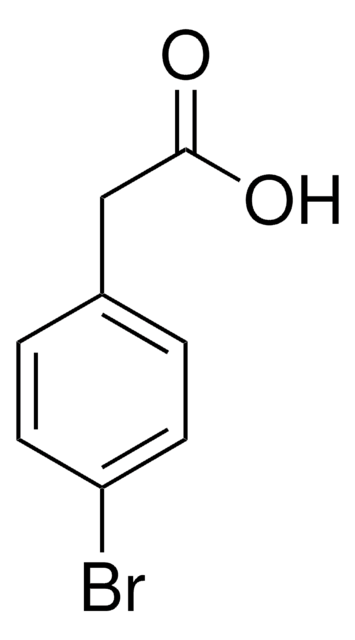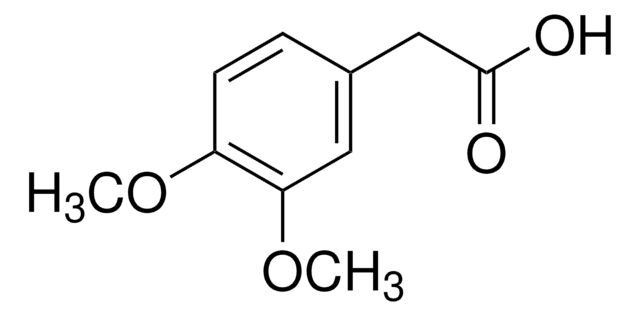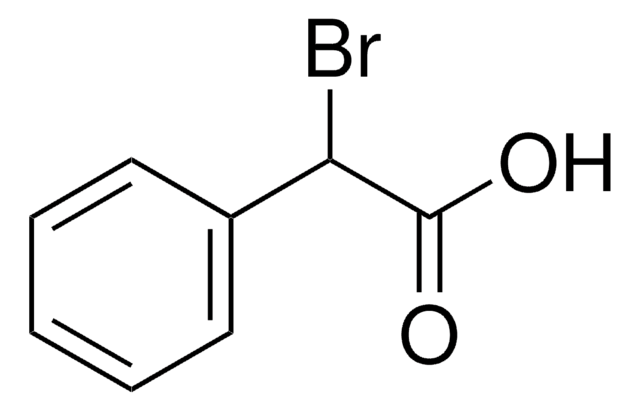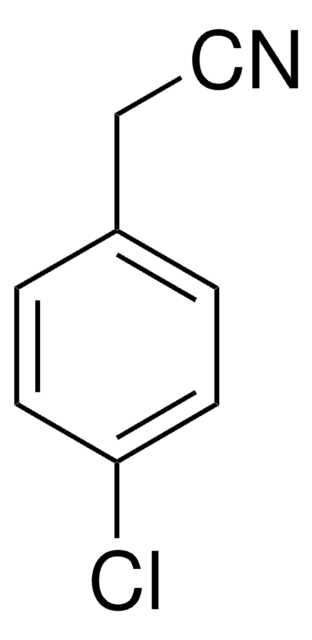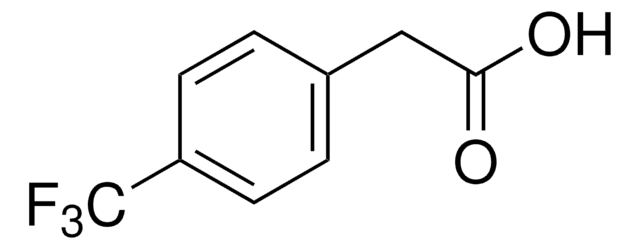All Photos(3)
About This Item
Linear Formula:
ClC6H4CH2CO2H
CAS Number:
Molecular Weight:
170.59
Beilstein/REAXYS Number:
1072816
EC Number:
MDL number:
UNSPSC Code:
12352100
PubChem Substance ID:
NACRES:
NA.22
Recommended Products
Quality Level
product line
ReagentPlus®
assay
99%
mp
102-105 °C (lit.)
solubility
ethanol: soluble 100 mg/mL, clear, faintly yellow
functional group
carboxylic acid
chloro
SMILES string
OC(=O)Cc1ccc(Cl)cc1
InChI
1S/C8H7ClO2/c9-7-3-1-6(2-4-7)5-8(10)11/h1-4H,5H2,(H,10,11)
InChI key
CDPKJZJVTHSESZ-UHFFFAOYSA-N
Looking for similar products? Visit Product Comparison Guide
General description
4-Chlorophenylacetic acid possess anticancer properties. It is a novel therapeutic agent which can be useful in prevention or treatment of estrogen-sensitive breast cancer. It acts as carbon and energy supplement and is degraded by Pseudomonas sp. strain CBS3.
Application
4-Chlorophenylacetic acid was used to study the mechanism of aerobic degradation of 1,1-dichloro-2,2-bis(4-chlorophenyl)ethane by Ralstonia eutropha A5.
Legal Information
ReagentPlus is a registered trademark of Merck KGaA, Darmstadt, Germany
signalword
Warning
hcodes
Hazard Classifications
Acute Tox. 4 Dermal - Acute Tox. 4 Inhalation - Eye Irrit. 2 - Skin Irrit. 2
Storage Class
11 - Combustible Solids
wgk_germany
WGK 3
ppe
dust mask type N95 (US), Eyeshields, Gloves
Choose from one of the most recent versions:
Already Own This Product?
Find documentation for the products that you have recently purchased in the Document Library.
Customers Also Viewed
Hay et al.
FEMS microbiology ecology, 31(3), 249-253 (2000-03-17)
Evidence is presented demonstrating the ability of Ralstonia eutropha A5 to degrade 1,1-dichloro-2,2-bis(4-chlorophenyl)ethane (DDD) aerobically. Strain A5 was able to effect significant transformation of [(14)C]DDD: the hexane extractable radioactivity decreased to approximately 50% of the controls while more than 25%
Neil Sidell et al.
Cancer letters, 251(2), 302-310 (2007-01-12)
Treatment of estrogen-sensitive breast cancer with selective estrogen selective modulators (SERMs) and, more recently, aromatase inhibitors has met with wide success. However, antagonism of estrogen receptor (ER) activity in breast carcinomas by SERMs such as tamoxifen has been associated with
N Sidell et al.
British journal of cancer, 89(2), 412-419 (2003-07-17)
We have investigated the effects of the low-toxic retinoid, all-trans retinoyl beta-glucuronide (RAG) alone and in combination with the phenylacetate (PA) derivative 4-chloro-phenylacetate (4-CPA) on the human neuroblastoma cell line, LA-N-5. In vitro studies demonstrated that RAG and 4-CPA treatments
S Sawatsri et al.
International journal of cancer, 93(5), 687-692 (2001-07-31)
The aromatic fatty acid phenylacetate (PA) and its analogs have come under intense investigation due to their ability to cause the growth arrest of a variety of neoplasia, including human breast cancer. We have determined that PA and its halide
A Markus et al.
Journal of bacteriology, 160(2), 618-621 (1984-11-01)
In cell-free extracts from Pseudomonas sp. strain CBS3 the conversion of 4-chlorophenylacetate to 3,4-dihydroxyphenylacetate was demonstrated. By Sephacryl S-200 chromatography two protein fractions, A and B, were obtained which both were essential for enzyme activity. Fe2+ and NADH were cofactors
Our team of scientists has experience in all areas of research including Life Science, Material Science, Chemical Synthesis, Chromatography, Analytical and many others.
Contact Technical Service


